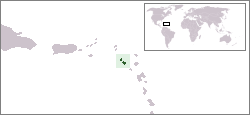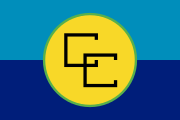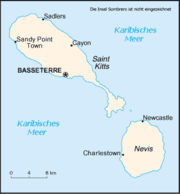Saint Kitts and Nevis
2008/9 Schools Wikipedia Selection. Related subjects: Americas; Countries
| Federation of Saint Christopher and Nevis Federation of Saint Kitts and Nevis1 |
||||||
|---|---|---|---|---|---|---|
|
||||||
| Motto: "Country Above Self" | ||||||
| Anthem: O Land of Beauty! Royal anthem: God Save the Queen |
||||||
|
|
||||||
| Capital (and largest city) |
Basseterre |
|||||
| Official languages | English | |||||
| Demonym | Kittitian, Nevisian | |||||
| Government | Parliamentary democracy and Federal constitutional monarchy | |||||
| - | Monarch | Queen Elizabeth II | ||||
| - | Governor-General | Sir Cuthbert Sebastian | ||||
| - | Prime Minister | Dr. Denzil Douglas | ||||
| Independence | ||||||
| - | from the United Kingdom | 19 September 1983 | ||||
| Area | ||||||
| - | Total | 261 km² ( 207th) 101 sq mi |
||||
| - | Water (%) | negligible | ||||
| Population | ||||||
| - | July 2005 estimate | 42,696 ( 209th) | ||||
| - | Density | 164/km² ( 64th) 424/sq mi |
||||
| GDP ( PPP) | 2002 estimate | |||||
| - | Total | $339 million ( 213th) | ||||
| - | Per capita | $14,649 ( 47th) | ||||
| HDI (2007) | ▼ 0.825 (high) ( 54th) | |||||
| Currency | East Caribbean dollar ( XCD) |
|||||
| Time zone | ( UTC-4) | |||||
| Internet TLD | .kn | |||||
| Calling code | +1 869 | |||||
| 1 | Or "Federation of Saint Christopher and Nevis". | |||||
| 2 | hdr.undp.org | |||||
The Federation of Saint Kitts and Nevis (also known as the Federation of Saint Christopher and Nevis), located in the Leeward Islands, is a federal two-island nation in the West Indies. It is the smallest nation in the Americas, in both area and population.
The capital city and headquarters of government for the federated state is on the larger island of Saint Kitts. The smaller state of Nevis lies about 2 miles (3 km) southeast of Saint Kitts, across a shallow channel called "The Narrows".
Historically, the British dependency of Anguilla was also a part of this union, which was then known collectively as Saint Christopher-Nevis-Anguilla.
Saint Kitts and Nevis are geographically part of the Leeward Islands. To the north-northwest lie the islands of Saint Eustatius, Saba, Saint Barthélemy, and Saint-Martin/Sint Maarten. To the east and northeast are Antigua and Barbuda, and to the southeast is the small uninhabited island of Redonda, and the island of Montserrat, which currently has an active volcano (see Soufrière Hills.)
Saint Kitts and Nevis were amongst the first islands in the Caribbean to be settled by Europeans. Saint Kitts was home to the first British and French colonies in the Caribbean.
Saint Kitts and Nevis is the smallest nation on Earth to ever host a World Cup event; it was one of the host venues of the 2007 Cricket World Cup.
Etymology
Saint Kitts was named " Liamuiga" by the Kalinago Indians who inhabited the island. This name, roughly translated in English means "fertile land," a testimony to the island's rich volcanic soil and high productivity.
Nevis' pre-Columbian name was "Oualie", which translates to "land of beautiful waters", presumably referred to the island's many freshwater springs and hot volcanic springs.
Christopher Columbus, upon sighting what we now call Nevis in 1498, gave that island the name San Martin (Saint Martin). However, the confusion of numerous, poorly-charted small islands in the Leeward Island chain, meant that the name ended up being accidentally transferred to another island, the one which we now know as the French/Dutch island Saint-Martin/Sint Maarten.
The current name "Nevis" is derived from a Spanish name Nuestra Señora de las Nieves, by a process of abbreviation and anglicization. This Spanish name means Our Lady of the Snows. It is not known who chose this name for the island, but it is a reference to the story of a 4th century Catholic miracle: a snowfall on a mountain near Rome. Presumably the white clouds which usually wreathe the top of Nevis Peak reminded someone of the story of a miraculous snowfall in a hot climate. The island of Nevis, upon first British settlement was referred to as "Dulcina", a name meaning "sweet one". Its original Spanish name, "Nuestra Señora de las Nieves", was eventually kept however, though it was soon shortened to "Nevis".
There is some disagreement over the name which Columbus gave to St. Kitts. For many years it was thought that he named the island San Cristobal, after his patron saint Saint Christopher, the saint of travelling. However, new studies suggest that Columbus named the island Sant Jago (Saint James). The name "San Cristobal" was apparently given by Columbus to the island we now know as Saba, 20 miles northwest. It seems that "San Cristobal" came to be applied to the island of St. Kitts only as the result of a mapping error. No matter the origin of the name, the island was well documented as "San Cristobal" by the 17th century. The first British colonists kept the English translation of this name, and dubbed it "St. Christopher's island." In the 17th century Kit, or Kitt, was a common abbreviation for the name Christopher, and so the island was often informally referred to as "Saint Kitt's island," which was further shortened to "Saint Kitts."
History
The islands of Saint Kitts and Nevis are two of the Caribbean's oldest colonised territories. Saint Kitts became the first British colony in the West Indies in 1624 and then became the first French colony in the Caribbean in 1625, when both nations decided to partition the island.
Five thousand years prior to European arrival, the island was settled by Indian peoples. The latest arrivals, the Kalinago peoples, arrived approximately 3 centuries before the Europeans. The Kalinago allowed the Europeans to colonize Saint Kitts, while earlier attempts to settle other islands were met with immediate destruction of the colonies by the Indians. The Kalinago were eventually wiped out in the great Kalinago Genocide of 1626.
The island of Nevis was colonized in 1628 by British settlers from Saint Kitts. From there, Saint Kitts became the premier base for British and French expansion, as the islands of Antigua, Montserrat, Anguilla and Tortola for the British, and Martinique, the Guadeloupe archipelago and St. Barths for the French were colonized from it.
Although small in size, and separated by only 2 miles (3 km) of water, the two islands were viewed and governed as different states until the late 19th century, when they were forcefully unified along with the island of Anguilla by the British. To this day relations are strained, with Nevis accusing Saint Kitts of neglecting its needs.
Saint Kitts and Nevis, along with Anguilla, became an associated state with full internal autonomy in 1967. Angullians rebelled, and their island was allowed to separate from the others in 1971. St. Kitts and Nevis achieved independence in 1983. It is the newest sovereign nation in the Americas. In August 1998, a vote in Nevis on a referendum to separate from St. Kitts fell short of the two-thirds majority needed. In late September 1998, Hurricane Georges caused approximately $445 million in damages and limited GDP growth for the year.
Alexander Hamilton, the first United States Secretary of the Treasury, was born in Nevis; he spent his childhood there and on St. Croix, then belonging to Denmark, and now one of the United States Virgin Islands.
Politics
The country is an independent Commonwealth realm with Queen Elizabeth II as its head of state, represented in St. Kitts and Nevis by a Governor-General, who acts on the advice of the Prime Minister and the Cabinet. The prime minister is the leader of the majority party of the House, and the cabinet conducts affairs of state.
St. Kitts and Nevis has a unicameral legislature, known as the National Assembly. It is composed of fourteen members: eleven elected Representatives (three from the island of Nevis) and three Senators who are appointed by the Governor-General. Two of the senators are appointed on the advice of the Prime Minister, and one on the advice of the leader of the opposition. Unlike in other countries, senators do not constitute a separate Senate or upper house of parliament, but sit in the National Assembly, alongside representatives. All members serve five-year terms. The Prime Minister and the Cabinet are responsible to the Parliament.
Saint Kitts and Nevis is a full and participating member of the Caribbean Community (CARICOM) and the Organisation of Eastern Caribbean States (OECS).
Geography
The country has two main islands, Saint Kitts and Nevis. The highest peak, at 1,156 metres, is Mount Liamuiga.
The islands are of volcanic origin, with large central peaks covered in tropical rainforest; the steeper slopes leading to these peaks are mostly uninhabited. The majority of the population on both islands lives closer to the sea where the terrain flattens out. There are numerous rivers descending from the mountains of both islands, which provide fresh water to the local population. St. Kitts also has one small lake.
Economy
Saint Kitts and Nevis is very small for a country. It is 1 1/2 times the size of Washington D.C. Saint Kitts and Nevis is a twin-island federation whose economy is characterized by its dominant tourism, agriculture and light manufacturing industries. Sugar was the primary export from the 1640s on, but rising production costs, low world market prices, and the government's efforts to reduce dependence on it have led to a growing diversification of the agricultural sector. In 2005, the government decided to close down the state-owned sugar company, which had caused losses and was a significant contributor to the fiscal deficit. Former sugar plantations still dominate the St. Kitts landscape. The agricultural, tourism, export-oriented manufacturing, and offshore-banking sectors are being developed and are now taking larger roles in the country’s economy. The growth of the tourism sector has become the main foreign exchange earner for Saint Kitts and Nevis. The country has also developed a successful apparel assembly industry and one of the largest electronics assembly industries in the Caribbean.
During the 1990s, Saint Kitts and Nevis registered an annual GDP growth of 5.5 percent, but the strong growth was interrupted by devastating hurricanes in 1998 and 1999. Post-hurricane reconstruction led to an economic resumption in 2000 with GDP growing 6.2 percent. The year 2001 began well enough although the post-hurricane construction boom was over and growth was slowing from its 2000 rate. But after September 11, tourism arrivals dropped off precipitously and activity in related sectors of the economy such as road construction and retail sales declined along with tourism. As a result, the GDP growth declined substantially in 2001 and 2002. Economic activity has recovered since 2003, mainly driven by strong growth in tourism. In view of its high level of public debt, the country needs a prudent fiscal policy to ensure sustainable economic growth.
Education
There are seven publicly administered high/secondary level schools in St Kitts-Nevis, and several private secondary schools. These are:
Public: Cayon High School (CHS) Basseterre High School (BHS) Washington Archibald High School (WAHS) Verchilds High School (VHS) Sandy Point High School (SPHS) Charlestown Secondary School (CSS) Gingerland Secondary School (GSS)
Private: St Theresa's Convent, Lyn Jeffers Secondary School






